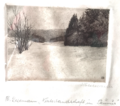Heinrich Gesemann
Heinrich Johann Karl Gesemann (born December 12, 1886 in Frankfurt am Main , † January 21, 1939 in Genoa ) was a German painter and co-founder and board member of the Westmark Artists Association .
Life and education
Gesemann was born in Frankfurt am Main as the only son of Karl and Margarete Gesemann, who ran a craft business as wheelwright . After primary and secondary school he completed an apprenticeship in lithography in Frankfurt. Thanks to his very good graduation, he was able to continue his training as a graphic artist and painter at the Städelschule ( Städel Institute, today State University of Fine Arts ) and finish with the exam at the Munich Painting Academy .
Gesemann maintained contacts with the artist colonies in the Spessart and Odenwald , where he met Hans Thoma , who was professor and director of the Kunsthalle in Karlsruhe and who influenced his painting, which was characterized by a concentration on landscape and natural motifs from the Rhenish low mountain range.
Gesemann lived and worked after his training in the High Fens near Monschau , where he met his future wife Maria. During this time numerous works were created in oil or as prints, most of which had the quiet German low mountain range as their theme. Gesemann was awarded a scholarship in Rome , which he could not use because of the outbreak of the First World War . During the war he worked as a draftsman in aircraft construction, where u. a. Etchings related to aviation were created.
After the end of the war, he moved with his wife to Enkirch on the Moselle in 1920 and set up a studio in the oldest, then dilapidated Enkircher mill (called Klonigersmühle or Schlossmühle), which is now called the “Gesemannsmühle” by the local population and in the middle of the one loved by the artist natural, secluded surroundings of the Ahringsbach (a side valley of the Moselle).
As an artist
He became friends with the artist Friedrich Karl Ströher from the neighboring Hunsrück town of Irmenach , which led to the establishment of the Westmark Artists' Association in the spring of 1921. a. with the aim of giving art and German artists a voice in the then French-occupied Rhineland. Like his friend Ströher, Gesemann suffered from the economic hardship of the 1920s, as there was virtually no market for the sale of works of art. Fifteen artists, including from Enkirch, Godesberg, Irmenach, Cologne, Koblenz and Trier, followed the spirit of optimism that led to the founding of artist associations in cities such as Düsseldorf and Berlin.
The board of directors of the Künstlerbund Westmark were Ströher and Gesemann, who u. a. with traveling exhibitions in the entire Rhineland and in 1922 with an exhibition in the Berlin Künstlerhaus under the motto of the association “Inspired by inner conviction” to provide a forum for the artistic awakening in the period between the world wars.
During this time Gesemann created etchings and oil paintings, which are said to be related to Caspar David Friedrich and above all to his mentor Hans Thoma.
Gesemann fell ill during a trip to the Mediterranean and died on January 21, 1939 in a hospital in Genoa.
Gesemann found his final resting place in the cemetery of his adopted home Enkirch .
After the Second World War , his wife Maria took over the mill, renovated it and maintained a rest home there until the 1950s. Gesemann's life's work was honored in various exhibitions; his pictures, graphics and etchings are in smaller collections or private collections.
Only a few hundred meters away from the “Gesemannsmühle”, the Enkirch painter Josef Candels lived and worked later in the Enkirch Ahringstal.
Traces of Gesemann in Enkirch and the surrounding area
- Information and pictures can be found in the Enkircher Heimatmuseum
- A larger painting is in the Catholic Church in Traben-Trarbach
- His former home and studio Gesemannsmühle is located directly on the Leiermanspfad flank of the Moselsteig , but cannot be visited.
Works
literature
- Brochure Inspired by inner conviction ... Artistic awakening in the southern Rhine province after the First World War , co-author: Dr. Fritz Schellack, co-editor: Hunsrück Museum in Simmern where this can still be obtained. German National Library
- The Rhineland - images of the country, people and art. Volume 2: Moselle. 1925. Ludwig Mathar . See page 320. ( With a cover picture by Heinrich Gesemann-Enkirch ). German National Library
- Flyer "Painting exhibition on the 100th birthday of Heinrich Gesemann" from the Enkirch Local Authority and Tourist Office (12–28 September 1986).
Web links
- Information on the Künstlerbund Westmark and Heinrich Gesemann at Eifel & Kunst
- Information on Heinrich Gesemann and other artists from the Enkirch neighboring community of Starkenburg
- Community Foundation Enkirch
| personal data | |
|---|---|
| SURNAME | Gesemann, Heinrich |
| ALTERNATIVE NAMES | Gesemann, Heinrich Johann Karl (full name) |
| BRIEF DESCRIPTION | German painter and co-founder as well as board member of the Westmark Artists Association |
| DATE OF BIRTH | December 12, 1886 |
| PLACE OF BIRTH | Frankfurt am Main |
| DATE OF DEATH | January 21, 1939 |
| Place of death | Genoa |





